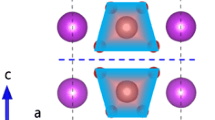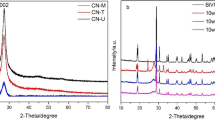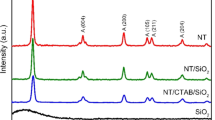Abstract
The visible-light responsive BiVO4/TiO2 core–shell heterojunction photocatalyst was prepared by precipitation method. The crystal structure and optical properties of the samples were characterized. The XRD results indicated that the vector was anatase TiO2. EDS, XPS and XRD showed that BiVO4 was coated on the surface of TiO2. SPV and UV–Vis spectra certified that the BiVO4/TiO2 photocatalyst possessed better absorption in the visible-light region (425–470 nm). The optical band gap of BiVO4/TiO2 photocatalyst ranged from 2.38 to 2.14 eV and decreased with the BiVO4 amount increase from 2 to 6 mmol L−1. Compared to TiO2, the BiVO4/TiO2 photocatalyst exhibited much higher photocatalytic activity in degradation of methyl orange under visible light irradiation and lower photocatalytic activity in UV-light. Moreover, the effect of the different in formation mechanism of TiO2/BiVO4 and BiVO4/TiO2 on the photocatalytic activity was investigated in detail. The photocatalytic mechanism of BiVO4/TiO2 core–shell structure was discussed, which indicated that photoelectron reduction was the major degradation mechanism in this system. When TiO2 particles were properly coated with BiVO4 layer and the Bi/Ti molar ratio of 1:32, the composite photocatalyst could absorb UV-light and visible light at the same time, so the BiVO4/TiO2 core–shell heterojunction photocatalyst had the optimal photocatalytic activity in visible light irradiation, which was attributed to the spatial transfer of visible-excited high-energy electrons from TiO2 to BiVO4.
Graphical Abstract














Similar content being viewed by others
References
R. Kaplan, B. Erjavec, G. Dražić, J. Grdadolnik, A. Pintar, Simple synthesis of anatase/rutile/brookite TiO2 nanocomposite with superior mineralization potential for photocatalytic degradation of water pollutants. Appl. Catal. B 181, 465–474 (2016). https://doi.org/10.1016/j.apcatb.2015.08.027
D. Zhang, G. Li, H. Wang, K.M. Chan, J.C. Yu, Biocompatible anatase single-crystal photocatalysts with tunable percentage of reactive facets. Cryst. Growth Des. 10, 1130–1137 (2015). https://doi.org/10.1021/cg900961k
H. Li, L. Zhu, C. Ma, H. Zhang, TiO2 hollow microspheres: synthesis, photocatalytic activity, and selectivity for a mixture of organic dyes. Monatsh. Chem. 145, 29–37 (2014). https://doi.org/10.1007/s00706-013-1012-9
G. Li, H. Zhang, J. Lan, J. Li, Q. Chen, J. Liu, G. Jiang, Hierarchical hollow TiO2 spheres: facile synthesis and improved visible-light photocatalytic activity. Dalton Trans. 42, 8541–8544 (2013). https://doi.org/10.1039/c3dt50503k
P. Zhang, A. Li, J. Gong, Hollow spherical titanium dioxide nanoparticles for energy and environmental applications. Particuology 22, 13–23 (2015). https://doi.org/10.1016/j.partic.2015.03.001
C. Zhang, Y. Zhou, Y. Zhang, S. Zhao, J. Fang, X. Sheng, T. Zhang, H. Zhang, Double-shelled TiO2 hollow spheres assembled with TiO2 nanosheets. Chem. Eur. J. 23, 4336–4343 (2017). https://doi.org/10.1002/chem.201602654
M.A.M. Adnan, N.M. Julkapli, S.B.A. Hamid, Review on ZnO hybrid photocatalyst: impact on photocatalytic activities of water pollutant degradation. Rev. Inorg. Chem. 36, 77–104 (2016). https://doi.org/10.1515/revic-2015-0015
C. Sushma, S.G. Kumar, Advancements in the zinc oxide nanomaterials for efficient photocatalysis. Chem. Pap. 71, 2023–2042 (2017). https://doi.org/10.1007/s11696-017-0217-5
W.B. Cross, I.P. Parkin, Aerosol assisted chemical vapour deposition of tungsten oxide films from polyoxotungstate precursors: active photocatalysts. Chem. Commun. 14, 1696–1697 (2003). https://doi.org/10.1039/b303800a
H. Zheng, J.Z. Ou, M.S. Strano, R.B. Kaner, A. Mitchell, K. Kalantar-zadeh, Nanostructured tungsten oxide-properties, synthesis, and applications. Adv. Funct. Mater. 21, 2175–2196 (2011). https://doi.org/10.1002/adfm.201002477
M. Mohamed, W. Salleh, J. Jaafar, M. Rosmi, Z. Hir, M. Mutalib, A. Ismail, M. Tanemura, Carbon as amorphous shell and interstitial dopant in mesoporous rutile TiO2: bio-template assisted sol-gel synthesis and photocatalytic activity. Appl. Surf. Sci. 393, 46–59 (2017). https://doi.org/10.1016/j.apsusc.2016.09.145
M. Mohamed, J. Jaafar, M. Zain, L. Minggu, M. Kassim, M. Rosmi, N. Alias, N. Nor, W. Salleh, M. Othman, In-depth understanding of core-shell nanoarchitecture evolution of g-C3N4@C, N co-doped anatase/rutile: efficient charge separation and enhanced visible-light photocatalytic performance. Appl. Surf. Sci. 436, 302–318 (2017). https://doi.org/10.1016/j.apsusc.2017.11.229
M. Mohamed, M. Zain, L. Minggu, M. Kassim, J. Jaafar, N. Amin, Y. Ng, Revealing the role of kapok fibre as bio-template for In-situ construction of C-doped g-C3N4@C, N co-doped TiO2 core-shell heterojunction photocatalyst and its photocatalytic hydrogen production performance. Appl. Surf. Sci. 476, 205–220 (2019). https://doi.org/10.1016/j.apsusc.2019.01.080
N. Rosman, W. Salleh, A. Ismail, J. Jaafar, Z. Harun, F. Aziz, M. Mohamed, B. Ohtani, M. Takashima, Photocatalytic degradation of phenol over visible light active ZnO/Ag2CO3/Ag2O nanocomposites heterojunction. J. Photochem. Photobiol. A 364, 602–612 (2018). https://doi.org/10.1016/j.jphotochem.2018.06.029
A. Kudo, K. Ueda, H. Kato, I. Mikami, Photocatalytic O2 evolution under visible light irradiation on BiVO4 in aqueous AgNO3 solution. Chem. Lett. 53, 229–230 (1998). https://doi.org/10.1023/A:1019034728816
M. Long, W. Cai, Photoelectrochemical properties of BiVO4 film electrode in alkaline solution. Chin. J. Catal. 29, 881–883 (2008). https://doi.org/10.1016/S1872-2067(08)60069-8
A.B. Murphy, P.R.F. Barnes, L.K. Randeniya, I.C. Plumb, I.E. Grey, M.D. Horne, J.A. Glasscock, Efficiency of solar water splitting using semiconductor electrodes. Int. J. Hydrog. Energy 31, 1999–2017 (2006). https://doi.org/10.1016/j.ijhydene.2006.01.014
T. Saison, N. Chemin, C. Chaneac, O. Durupthy, V. Ruaux, L. Mariey, F. Mauge, P. Beaunier, J.P. Jolivet, Bi2O3, BiVO4, and Bi2WO6: impact of surface properties on photocatalytic activity under visible light. J. Phys. Chem. C 115, 5657–5666 (2011). https://doi.org/10.1021/jp109134z
L.S. Zhang, H.L. Wang, Z.G. Chen, P.K. Wong, J.S. Liu, Bi2WO6 micro/nano-structures: synthesis, modifications and visible-light-driven photocatalytic applications. Appl. Catal. B 106, 1–13 (2011). https://doi.org/10.1016/j.apcatb.2011.05.008
T. George, S. Joseph, A.T. Sunny, S. Mathew, Visible-light photocatalytic activities of alpha-AgVO3 nanorods and BiVO4 nanobars. Int. J. Nanotechnol. 8, 963–978 (2011). https://doi.org/10.1504/IJNT.2011.044440
A. Iwase, A. Kudo, Photoelectrochemical water splitting using visible-light-responsive BiVO4 fine particles prepared in an aqueous acetic acid solution. J. Mater. Chem. 20, 7536–7542 (2010). https://doi.org/10.1039/c0jm00961j
H. Kato, M. Hori, R. Konta, Y. Shimodaira, A. Kudo, Construction of Z-scheme type heterogeneous photocatalysis systems for water splitting into H2 and O2 under visible light irradiation. Chem. Lett. 33, 1348–1349 (2004). https://doi.org/10.1246/cl.2004.1348
Z.Q. Wang, W.J. Luo, S.C. Yan, J.Y. Feng, Z.Y. Zhao, Y.S. Zhu, Z.S. Li, Z.G. Zou, BiVO4 nano-leaves: mild synthesis and improved photocatalytic activity for O2 production under visible light irradiation. CrystEngComm 13, 2500–2504 (2011). https://doi.org/10.1039/C0CE00799D
M. Long, W. Cai, J. Cai, B. Zhou, X. Chai, Y. Wu, Efficient photocatalytic degradation of phenol over Co3O4/BiVO4 composite under visible light irradiation. J. Phys. Chem. B 38, 20211–20216 (2007). https://doi.org/10.1021/jp063441z
S. Kohtani, M. Koshiko, A. Kudo, K. Tokumura, Y. Ishigaki, A. Toriba, K. Hayakawa, R. Nakagaki, Photodegradation of 4-alkylphenols using BiVO4 photocatalyst under irradiation with visible light from a solar simulator. Appl. Catal. B 46, 573–586 (2003). https://doi.org/10.1016/S0926-3373(03)00320-5
X. Zhang, Z.H. Ai, F.L. Jia, L.Z. Zhang, X.X. Fan, Z.G. Zou, Selective synthesis and visible-light photocatalytic activities of BiVO4 with different crystalline phases. Mater. Chem. Phys. 103, 162–167 (2007). https://doi.org/10.1016/j.matchemphys.2007.02.008
K. Soma, A. Iwase, A. Kudo, Enhanced activity of BiVO4 powdered photocatalyst under visible light irradiation by preparing microwave-assisted aqueous solution methods. Catal. Lett. 144, 1962–1967 (2014). https://doi.org/10.1007/s10562-014-1361-y
M. Xie, X. Fu, L. Jing, P. Luan, Y. Feng, H. Fu, Long-lived, visible-light-excited charge carriers of TiO2/BiVO4 nanocomposites and their unexpected photoactivity for water splitting. Adv. Energy. Mater. 4, 4–9 (2014). https://doi.org/10.1002/aenm.201300995
H. Jung, Y.C. Sang, C. Shin, B.K. Min, O.S. Joo, Y.J. Hwang, Effect of the Si/TiO2/BiVO4 heterojunction on the onset potential of photocurrents for solar water oxidation. ACS Appl. Mater. Inter. 7, 5788–5796 (2015). https://doi.org/10.1021/am5086484
H. Zhang, C. Cheng, Three-dimensional FTO/TiO2/BiVO4 composite inverse opals photoanode with excellent photoelectrochemical performance. ACS Energy Lett. 2, 813–821 (2017). https://doi.org/10.1021/acsenergylett.7b00060
J. Bian, Y. Qu, X. Zhang, N. Sun, D. Tang, L. Jing, Dimension-matched plasmonic Au/TiO2/BiVO4 nanocomposites as efficient wide-visible-light photocatalysts to convert CO2 and mechanism insights. J. Mater. Chem. A 6, 11838–11845 (2018). https://doi.org/10.1039/C8TA02889C
J. Resasco, H. Zhang, N. Kornienko, N. Becknell, H. Lee, J. Guo, A.L. Briseno, P. Yang, TiO2/BiVO4 nanowire heterostructure photoanodes based on type II band alignment. ACS Cent. Sci. 2, 80–88 (2016). https://doi.org/10.1021/acscentsci.5b00402
P.P. Liu, X. Liu, X.H. Huo, Y. Tang, J. Xu, H. Ju, TiO2-BiVO4 heterostructure to enhance photoelectrochemical efficiency for sensitive aptasensing. ACS Appl. Mater. Interfaces. 9, 27185–27192 (2017). https://doi.org/10.1021/acsami.7b07047
S. Obreǵon, G. Coĺon, A ternary Er3+-BiVO4/TiO2 complex heterostructure with excellent photocatalytic performance. RSC Adv. 4, 6920–6926 (2014). https://doi.org/10.1039/c3ra46603e
Y. Hu, D. Li, Y. Zheng, W. Chen, Y. He, Y. Shao, X. Fu, G. Xiao, BiVO4/TiO2 nanocrystalline heterostructure: a wide spectrum responsive photocatalyst towards the highly efficient decomposition of gaseous benzene. Appl. Catal. B 104, 30–36 (2011). https://doi.org/10.1016/j.apcatb.2011.02.031
M. Zalfani, B.V. Schueren, Z.Y. Hu, J.C. Rooke, R. Bourguiga, M. Wu, Y. Li, G.V. Tendeloo, B.L. Su, Novel 3DOM BiVO4/TiO2 nanocomposites for highly enhanced photocatalytic activity. J. Mater. Chem. A 3, 21244–21256 (2015). https://doi.org/10.1039/c5ta00783f
R. Wang, J. Bai, Y. Li, Q. Zeng, J. Li, B. Zhou, BiVO4/TiO2(N2) nanotubes heterojunction photoanode for highly efficient photoelectrocatalytic applications. Nano-Micro. Lett. 9, 14 (2017). https://doi.org/10.1007/s40820-016-0115-3
W.J. Yin, S. Chen, J.H. Yang, X.G. Gong, Y. Yan, S.H. Wei, Effective band gap narrowing of anatase TiO2 by strain along a soft crystal direction. Appl. Phys. Lett. 96, 221901 (2010). https://doi.org/10.1063/1.3430005
K. Hu, L. E, D. Zhao, C. Hu, J. Cui, L. Lai, Q. Xiong, Z. Liu, Hydrothermal synthesis of a rutile/anatase TiO2 mixed crystal from potassium titanyl oxalate: crystal structure and formation mechanism. CrystEngComm 20, 3363–3369 (2018). https://doi.org/10.1039/c8ce00330k
A.L. Spek, Single-crystal structure validation with the program PLATON. J. Appl. Crystallogr. 36, 7–13 (2003). https://doi.org/10.1107/S0021889802022112
J. Tang, J. Ye, Correlation of crystal structures and electronic structures and photocatalytic properties of the W-containing oxides. J. Mater. Chem. 15, 4246–4251 (2005). https://doi.org/10.1039/b504818d
P. Li, S. Ouyang, G. Xi, T. Kako, J. Ye, The effects of crystal structure and electronic structure on photocatalytic H2 evolution and CO2 reduction over two phases of perovskite-structured NaNbO3. J. Phys. Chem. C 116, 7621–7628 (2012). https://doi.org/10.1021/jp210106b
X. Zhang, L. Zhang, T. Xie, D. Wang, Low-temperature synthesis and high visible-light-induced photocatalytic activity of BiOI/TiO2 heterostructures. J. Phys. Chem. C 113, 7371–7378 (2009). https://doi.org/10.1021/jp900812d
F. Wang, W. Li, S. Gu, H. Li, H. Zhou, X. Wu, Novel In2S3/ZnWO4 heterojunction photocatalysts: facile synthesis and high-efficiency visible-light-driven photocatalytic activity. RSC Adv. 5, 89940–89950 (2015). https://doi.org/10.1039/c5ra16243b
M. Wang, W. Li, Y. Zhao, S. Gu, F. Wang, H. Li, X. Liu, C. Ren, Synthesis of BiVO4–TiO2–BiVO4 three-layer composite photocatalyst: effect of layered heterojunction structure on the enhancement of photocatalytic activity. RSC Adv. 6, 75482–75490 (2016). https://doi.org/10.1039/c6ra16796a
K.L. Zhang, C.M. Liu, F.Q. Huang, C. Zheng, W.D. Wang, Study of the electronic structure and photocatalytic activity of the BiOCl photocatalyst. Appl. Catal. B 68, 125–129 (2006). https://doi.org/10.1016/j.apcatb.2006.08.002
P. Dong, Y. Wang, B. Cao, S. Xin, L. Guo, J. Zhang, F. Li, Ag3PO4/reduced graphite oxide sheets nanocomposites with highly enhanced visible light photocatalytic activity and stability. Appl. Catal. B 132, 45–53 (2013). https://doi.org/10.1016/j.apcatb.2012.11.022
L. Hoffart, U. Heider, R.A. Huggins, W. Witschel, R. Jooss, A. Lentz, Crystal growth and conductivity investigations on BiVO4 single crystals. Ionics 2, 34–38 (1996). https://doi.org/10.1007/BF02375866
T. Siefke, S. Kroker, K. Pfeiffer, O. Puffky, K. Dietrich, D. Franta, I. Ohlídal, A. Szeghalmi, E.-B. Kley, A. Tünnermann, Materials pushing the application limits of wire grid polarizers further into the deep ultraviolet spectral range. Adv. Opt. Mater. 4, 1780–1786 (2016). https://doi.org/10.1002/adom.201600250
S. Sarkar, N.S. Das, K.K. Chattopadhyay, Optical constants, dispersion energy parameters and dielectric properties of ultra-smooth nanocrystalline BiVO4 thin films prepared by rf-magnetron sputtering. Solid State Sci. 33, 58–66 (2014). https://doi.org/10.1016/j.solidstatesciences.2014.04.008
B. Wang, Z. Wan, H. Wu, S. Liu, Y. Chen, X. Sui, D. Yuan, Surface photovoltage: an efficient tool of evaluation of photocatalytical activity of materials. Adv. Mater. Res. 295–297, 614–617 (2011). https://doi.org/10.4028/www.scientific.net/AMR.295-297.614
X. Qian, D. Qin, Q. Song, Y. Bai, T. Li, X. Tang, E. Wang, S. Dong, Surface photovoltage spectra and photoelectrochemical properties of semiconductor-sensitized nanostructured TiO2 electrodes. Thin Solid Films 385, 152–161 (2001). https://doi.org/10.1016/S0040-6090(01)00771-4
A.B. Anderson, Derivation of the extended Hückel method with corrections: one electron molecular orbital theory for energy level and structure determinations. J. Chem. Phys. 62, 1187–1188 (1975). https://doi.org/10.1063/1.430562
F. Flores, J. Ortega, H. Vázquez, Modelling energy level alignment at organic interfaces and density functional theory. Phys. Chem. Chem. Phys. 11, 8658–8675 (2009). https://doi.org/10.1039/b902492c
J. Ma, S.H. Wei, T.A. Gessert, K.K. Chin, Carrier density and compensation in semiconductors with multiple dopants and multiple transition energy levels: case of Cu impurities in CdTe. Phys. Rev. B 83, 2335–2347 (2011). https://doi.org/10.1103/PhysRevB.83.245207
J.K. Cooper, S. Gul, F.M. Toma, L. Chen, P.A. Glans, J. Guo, J.W. Ager, J. Yano, I.D. Sharp, Electronic sStructure of monoclinic BiVO4. Chem. Mater. 26, 5365–5373 (2014). https://doi.org/10.1021/cm5025074
G. Smith, R. Crook, J. Wadhawan, Measuring the work function of TiO2 nanotubes using illuminated electrostatic force microscopy. J. Phys. 471, 012045 (2013). https://doi.org/10.1088/1742-6596/471/1/012045
Y. Huang, J. Wu, Hydrogen production from water splitting by semiconductor oxides photocatalysis. Prog. Chem. 18, 861–869 (2006). https://doi.org/10.3321/j.issn:1005-281X.2006.07.003
T. Saison, N. Chemin, C. Chanéac, O. Durupthy, L. Mariey, F. Maugé, V. Brezová, J.P. Jolivet, New insights into BiVO4 properties as visible light photocatalyst. J. Phys. Chem. C 119, 12967–12977 (2015). https://doi.org/10.1021/acs.jpcc.5b01468
P. Ju, Y. Wang, Y. Sun, D. Zhang, Controllable one-pot synthesis of a nest-like Bi2WO6/BiVO4 composite with enhanced photocatalytic antifouling performance under visible light irradiation. Dalton Trans. 45, 4588–4602 (2016). https://doi.org/10.1039/c6dt00118a
Acknowledgements
The authors gratefully acknowledge the financial support received from the Tianjin Natural Science Foundation (Grant No. 18JCYBJC87600) and the Key Projects of Tianjin Natural Science Foundation (Grant No. 16JCZDJC39100). The authors are indebted to Prof. L. Ge for his technical assistance in surface photovoltage spectroscopy (SPV).
Author information
Authors and Affiliations
Corresponding author
Ethics declarations
Conflict of interest
The authors declare no competing financial interest.
Additional information
Publisher's Note
Springer Nature remains neutral with regard to jurisdictional claims in published maps and institutional affiliations.
Electronic supplementary material
Below is the link to the electronic supplementary material.
Rights and permissions
About this article
Cite this article
Hu, K., E, L., Li, Y. et al. Photocatalytic Degradation Mechanism of the Visible-Light Responsive BiVO4/TiO2 Core–Shell Heterojunction Photocatalyst. J Inorg Organomet Polym 30, 775–788 (2020). https://doi.org/10.1007/s10904-019-01217-w
Received:
Accepted:
Published:
Issue Date:
DOI: https://doi.org/10.1007/s10904-019-01217-w




